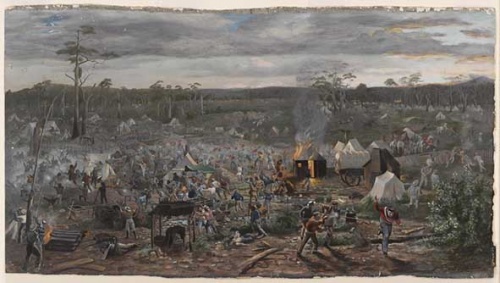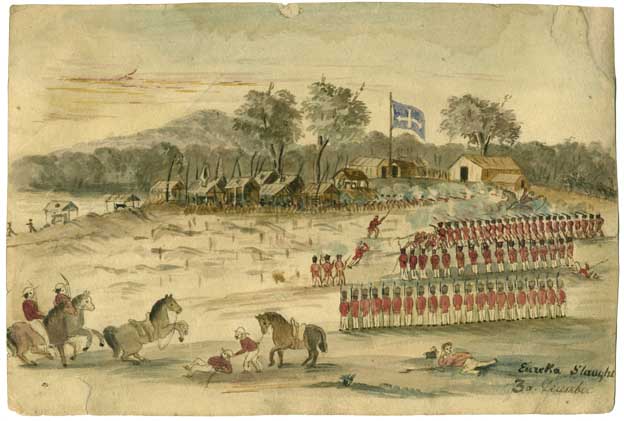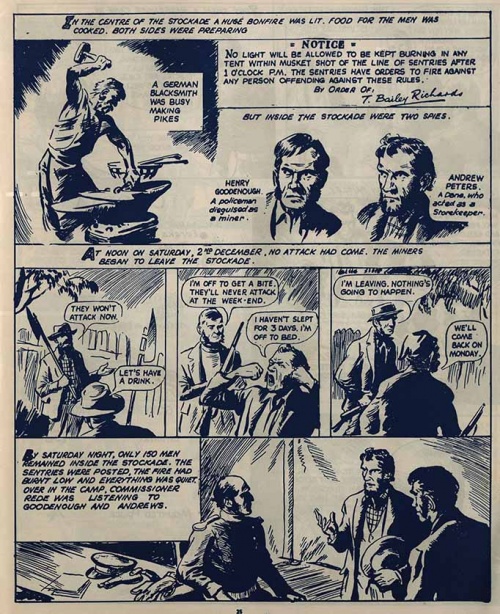Eureka Battle

This work is an over-painted photographic print, photographed by an unknown photographer from the painted canvas by Izett Watson and Thaddeus Welch, which was exhibited as a painted cyclorama in the 'Battle of Waterloo' Cyclorama building, Fitzroy, ca. 1891. This is based on the evidence that the pulleys and brick wall are discernible at the top edge of the image which B. Ireland has not over-painted.
Prior Events
For over one hundred years it was widely accepted that John Egan, the drummer boy of the 12th Regiment, was fatally wounded at Eureka. The truth however is that he was shot a few days prior to Eureka and survived. The drummer boy legend is but one small and intriguing facet of the exciting Eureka story. There was a gravestone erected in the Ballaarat [sic] Old Cemetery in recent years in memory of John Egan, drummer boy of the 12th Regiment of Foot, "killed in line of duty 28th November 1854." This tombstone stood in the same consecrated ground as the monument to the military who lost their lives at the Eureka Riots. However, John Egan did not die in the line of duty at Eureka. Despite the popularly held belief of the "death of the Drummer Boy," research has revealed that he was still alive in 1855. In 1856 he was transferred with the 12th Regiment to Tasmania and was still there on 30 June 1860, almost six years after Eureka. Many accounts of Eureka (including Sovereign Hill's Blood on the Southern Cross) claimed dramatically that "the little drummer boy" was "fatally wounded." In some accounts he was "trampled to death."
Ballarat in 1854 was a relatively stable field. Much of the surface alluvial gold had been worked out and deep shafts had to be dug to extract the treasure from the ground. This required groups of men to form partnerships, resulting in a more stable society. The grievances of the Ballarat miners were legitimate. They had been treated harshly and unjustly by the authorities. The government thought it necessary to quell the rising indignation of the aggrieved diggers. Pasley, the government engineer, described the crisis in a letter to his father as "a very grave one." The government "had given way to popular clamour more than once." A mob of diggers had threatened to "march up to the Government Camp and take an equal number of Commissioners prisoner and keep them as hostages. If any resistance was offered, they would set fire to the Camp and kill everyone." Pasley thought that if the government gave in to the diggers' demands "the consequences would be very serious." At the same time, if they resisted and were beaten in fight by the insurgents, Pasley had no doubt that a general rebellion would ensue.
With this in mind Charles Pasley examined the military camp. He found "a small force of about one hundred men in an exposed and defenceless camp consisting of tents and light wooden buildings by no means musketproof." The timber slabs of which the buildings were comprised had great holes between them through which daylight could be seen. If the military were attacked in this position the musket balls would fly straight through the buildings. Injuries to military personnel would be inevitable. There was civilian housing "pressing close upon the Camp." Pasley approached the townsfolk in tents near the camp and advised them to deposit all their valuables in the gold office as their tents would be fired and destroyed by the military if the government camp was attacked by the angry diggers. Military reinforcements were urgently needed. Captain Henry Wise with the 40th Regiment came up from Geelong: "On 27 November in Melbourne two officers and 50 men of the 40th Regiment proceeded by the one o'clock steamer to Geelong, to reinforce the detachment there to 100. Their orders were to proceed to Ballarat at once." They marched through the diggings with muskets loaded and bayonets fixed. This was a full show of force by the military. They were hooted by the populace, and stones were thrown at them. On 28 November 1854, a detachment of the 12th Regiment of Foot proceeded into Ballarat through the Eureka diggings. They had been requested urgently and had hurriedly departed from Melbourne for their destination, the government camp. They were set upon by the angry and incensed population on "the Eureka". This is undoubtedly when John Egan was shot in the leg, a fact corroborated by Assistant Surgeon George Arden of the 12th Regiment, examined under oath by the board "appointed to consider claims for compensation for losses sustained during the Ballarat riots:" " On the night of the 28th about 9 or 10 o'clock we got into the diggings. We had drays and it being quite dark and the horses jaded we were marching very slowly.
"As soon as we got into the diggings a mob of diggers collected and assailed us with cries of Joe! Joe! We were pelted with large stones and bottles. We had not stopped anywhere before we were assailed. The drivers knew the way. One of the carts was capsized, the driver and two men were severely injured, the men were turned out and ordered to load. We found two men missing and a party went back to find them. They were laying [sic] off the road badly wounded. When the soldiers turned out and loaded the crowd dispersed. Lieutenant Paul was ordered on with the carts. We were shortly after joined by the 40th men from the Camp. During the disturbance several shots were fired by the diggers, but the military never returned the fire. I am quite confident that not a shot was fired by the military. Our drummer boy was shot in the leg." John Egan who was "shot in the leg" was one of the drummer boys attached to the First Battalion, 12th Regiment. He was "despatched to Ballarat" during the 2nd Muster in November 1854. Of their arrival in Ballarat the Melbourne Argus reported on November 30: "Information reached us last evening that a portion of the military force despatched from town on Monday had arrived, and that in passing through the diggings the soldiers were pelted with broken glass and other missiles by some diggers. Our informant adds that the military received this manifestation of feeling in the best possible temper.
Another long article followed. It included the statement that: "A poor drummer was shot through the leg - are these deeds which will enlist the sympathy of an intelligent people? Is the maiming of a drummer boy a worthy triumph for a large mass of a British population who wish to occupy a creditable position in the eyes of the world? Surely not!" The wounding of the drummer boy was cleverly used to incense the general population and promote sympathy for the establishment. Doctor Carr of Eureka was also the Ballarat correspondent for the Argus. On December 15 he noted that he had observed the injured drummer boy in the hospital one week after the fight. This correlates with the Muster Lists of the 12th Regiment of Foot, that indicate that John Egan, Regimental Number 3159, drummer, was in the regimental hospital for 21 days following his injury, during the last quarter of 1854. While the drummer boy was recovering in hospital the culmination of years of bitterness and unrest took place. On 3 December, the military attacked the Eureka Stockade, a flimsy fort built by the miners in the vicinity of the Eureka Lead.
The Aftermath
A correspondent from the Geelong Advertiser reported in December 1854,
- The first thing I saw was a number of diggers enclosed in a sort of hollow square, many of them were wounded, the blood dripping from them as they walked; some were walking lame, pricked on by the bayonets of the soldiers bringing up the rear. The soldiers were much excited, and troopers madly so, flourishing their swords, and shouting out ... The scene was awful - twos and threes gathered together, and all felt stupefied. I went ... to the barricade, the tents all around were in a blaze; ... the spectacle was so ghastly that I feel a loathing at the remembrance. They all lay in a small space with their faces upwards, looking like lead; several of them were still heaving, and at every rise of their breasts, the blood spouted out of their wounds, or just bubbled out and trickled away. ...
A correspondent from the Melbourne Herald, like others of his kind, was appalled by the slaughter and wanton destruction that abounded. A correspondent in 18 December 1854 wrote:
- I was attracted by the smoke of the tents burnt by the soldiers, and there a most appalling sight presented itself. Many more are said to have been killed and wounded, but I myself saw eleven dead bodies of diggers lying within a very small space of ground, and the earth was besprinkled with blood, and covered with the smoking mass of tents recently occupied. Could the Government but have seen the awful sight presented at Ballarat on this Sabbath morning - the women in tears, mourning over their dead relations, and the blood-bespattered countenances of many men in the diggers' camp - it might have occurred to His Excellency that 'prevention is better than cure'. [1]
Casualties
The following deaths resulted from the Eureka Battle.
Diggers
James Brown, Frederick Coxhead, Alfred Crowe, John Diamond, George Donaghey, William Emmermann, Fenton, William Flower, Edward Flynn, Patrick Gittings, Samuel Green, John Hafele, Happy Jack, John Hynes, Robert Julien, Edward McGlynn, Thaddeus Moore, Thomas Mullins, Thomas O'Neill, Henry Powell, William Quinlan, Edward Quinn, John Robinson, Captain Charles Ross, Tom the Blacksmith, Edward Thonen
Military
Felix Boyle, John Hall, George Littlehales, Michael Roney, Henry Wise, William Webb
Onlookers
The following casualites resulted from the Eureka Battle, but later recovered.
Diggers
Frank Hasleham, Hardie (bro of Robert), Mrs Michael Noonan, Frederick Powlett, James Byrne, Patrick Callinan, Thomas Callinan, Michael Canny, Patrick Canny, Denis Dinan, Michael Hanley, Patrick Hannafin, Peter Lalor, Adolfus Lessman, Michael O'Neill, Luke Sheehan, James Symmons, James Warner
Military
Robert Adair, Benden Hassell, William Buttwell, Henry Cottes, William French, Timothy Galvin, Bernard O'Donnell, Lieutenant Paul, Capt Potts, Patrick Sullivan
Also See
References
- ↑ Melbourne Herald, 18 December 1854.


